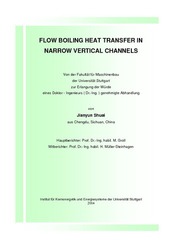| Departments | |
|---|---|
| Book Series (96) |
1378
|
| Nachhaltigkeit |
3
|
| Gesundheitswesen |
1
|
| Humanities |
2363
|
| Natural Sciences |
5406
|
| Engineering |
1791
|
| Engineering | 292 |
| Mechanical and process engineering | 861 |
| Electrical engineering | 686 |
| Mining and metallurgy | 30 |
| Architecture and civil engineering | 75 |
| Common |
98
|
|
Leitlinien Unfallchirurgie
5. Auflage bestellen |
|
Advanced Search
Flow Boiling Heat Transfer in Narrow Vertical Channels (English shop)
Jianyun Shuai (Author)Preview
Table of Contents, Datei (19 KB)
Preface, Datei (8.7 KB)
Extract, Datei (68 KB)
Saturated flow boiling heat transfer and flow visualization experiments were carried out in three vertical rectangular channels with dimensions (width×height) 2.0×4.0, 0.86×2.0 and 0.54×1.60 mm² (corresponding to hydraulic diameters 2.67, 1.20 and 0.81 mm, respectively). The channels were heated from three sides. Deionized water was used as the working fluid. The channel exit was at atmospheric pressure. Benchmark experiments of single-phase flow were also conducted for pressure drop and heat transfer. Experimental results show that for the 0.54×1.60 mm² channel, the singlephase friction factor is higher than predicted by well-accepted correlations, while for the other two channels it can be well correlated. The heat transfer performance for both laminar and turbulent regimes under asymmetric heating conditions is different from that under uniform heating conditions on which the existing correlations are based. Therefore single-phase heat transfer correlations were modified so that they could be incorporated into the two-phase heat transfer correlations employed for asymmetric heating conditions. For flow boiling, three basic flow patterns are observed for all the channels, viz., bubbly, slug and annular flow. However, based on the developed flow pattern maps, the transition from slug to annular flow for the 2.0×4.0 mm² channel occurs at a lower superficial vapor velocity than for the two small channels. This suggests that the nucleate boiling mechanism, which generally corresponds to slug flow, is more important for the two small channels. Saturated flow boiling heat transfer characteristics were investigated under different heat flux, mass flux and vapor quality. The experimental local heat transfer coefficient for the 2.0×4.0 mm² channel is in good agreement with the modified Kandlikar correlation and the Shah correlation. For the smaller channels (0.86×2.0 mm² and 0.54×1.60 mm²), the heat transfer characteristics are not dominated by the convective boiling mechanism. On the contrary, the nucleate boiling term of the Kandlikar correlation predicts the experimental heat transfer coefficient relatively well. Two new correlations have been developed in which the local two-phase heat transfer coefficient is related to the single-phase heat transfer coefficient by a twophase multiplier, which is a function of the Boiling number and thermodynamic vapor quality. The developed correlations show rather good agreement with experimental results.
| ISBN-13 (Printausgabe) | 3865372406 |
| ISBN-13 (Hard Copy) | 9783865372406 |
| ISBN-13 (eBook) | 9783736912403 |
| Language | German |
| Page Number | 136 |
| Edition | 1 Aufl. |
| Volume | 0 |
| Publication Place | Göttingen |
| Place of Dissertation | Stuttgart |
| Publication Date | 2004-10-14 |
| General Categorization | Dissertation |
| Departments |
Mechanical and process engineering
|








